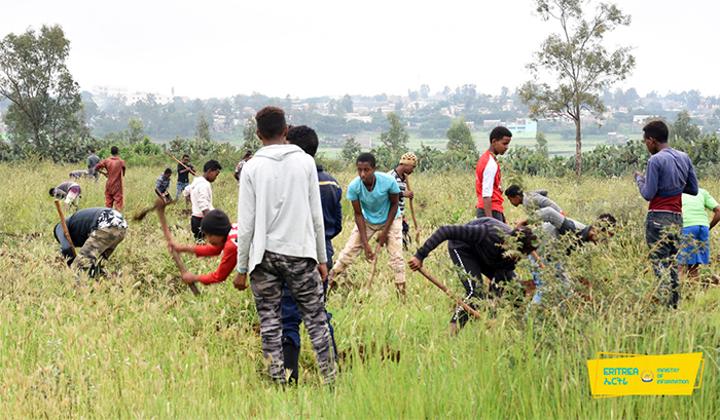Africa-Press – Eritrea. In equal pacing with the extreme advancement of humans, the earth is coming to the worst of degradation and negative transformation. We have reached a stage where our survival is being threatened mainly due to our unreasonable extraction of resources and emission of waste. For many years now, the natural setting of the world has been gradually changing into an environment that is less suitable for its inhabitants. It might already be late now, but it is never too late to take action. On January 30, 1995, the United Nations General Assembly officially proclaimed June 17 as the United Nations Convention to Combat Desertification and Drought day, later named World’s Desertification and Drought Observance day. This was done to raise worldwide awareness of people about drought and land degradation or desertification.
It all started to go wrong when nations began to develop and modernize, demanding extensive amounts of resources to meet the needs of their people’s new lifestyles. Increased wealth and urbanization are seeking more land for food, animal feed and clothing, which is fiber.
And the productivity of the remaining arable land is declining and the climate is also changing, further contributing to desertification.
According to a statistical report of the United Nations Convention to Combat Desertification (UNCCD), today, more than two billion hectares of previously productive land is degraded, leaving over 70 percent of natural ecosystems affected. By 2050, this could reach 90 percent. By 2030, food production will require an additional 300 million hectares of land and the fashion industry is predicted to use 35 percent more land – which is over 115 million hectares. Clothing and footwear production causes 8 percent of global greenhouse gas emissions, a figure predicted to rise to almost 50 percent by 2030. Of course, dietary change can free up between 80 and 240 million hectares of land and eliminating waste can free up land used to produce 1.3 billion tons of food, which reserves 1.4 billion hectares of land. But with the most basic of our needs being the products of the land, nothing could be more devastating than the fact that it is running out of service.
In his address last year, Mr. Ibrahim Thiew, Executive Secretary of the UNCCD, said: “If we keep producing and consuming as usual, we will eat into the planet’s capacity to sustain life until there is nothing left but scraps. We all need to make better choices about what we eat and what we wear to help protect and restore the land.” That way, we can embrace the benefits of the land and ensure our survival. As many scholars agree, desertification and climate change, both individually and in combination, are reducing the provision of dryland ecosystem services and negatively affecting ecosystem health, including losses in biodiversity.
In Eritrea, since some people depend on agriculture for their livelihood, land is a center of gravity for the government’s policies. For this reason, the Government of Eritrea has been working prudently to improve land productivity and to minimize land degradation. To restore degraded land and improve land productivity, the Government of Eritrea has been taking major initiatives including farm soil and water conservation programs, construction of water reservoirs as well as launching of the Greening Campaign.
In spite of that, Eritrea’s natural location makes it prone to adverse effects of drought and desertification. This natural challenge is aggravated by man-made interferences such as the cutting of trees for firewood and to expand farmland and overgrazing.
In order to mitigate the effects of drought and desertification in Eritrea, the following actions must be enforced.
Every renovation begins with raising awareness of the public. That is why concerned government bodies have been working to raise people’s awareness about the importance of the conservation of the environment, in general, and the conservation of soil fertility, in particular. That was supported by promoting community-based activities to improve land productivity and by harvesting water from all kinds of sources and using it in improving agricultural productivity.
For people to stop cutting trees down for firewood and construction, an alternative source of energy and house construction material should be provided. For this reason, the Eritrean Government has been working to introduce sustainable alternative sources of energy and construct permanent stone-made housing settlements for the people.
Though Eritrea is one of the countries that are in great danger of desertification, the issue is relevant to all countries and seeks global cooperation. Hence, fostering regional and international engagements through pragmatic initiatives is one of the measures that are being taken to combat desertification.
According to Mr. Fitsum Hagos, Director of Wild Life Conservation at the Forestry and Wild Life Authority, the Eritrean Government has mapped 14 forest and wild life protected land in different parts of the country, including Hawashayt, Nakfa, Dige and Rahrihe. However only six of them, namely, Gash Setit Elephant Sanctuary, Semienawi-Debubawi Green Belts, Dahlak Island Forest and Wild Life Reservation, Ber’asole and Kerkebet, are being actively worked on.
Desertification is caused by many factors that influence one another. They include climate change, the amount of rainfall and soil salinity. However, the factor that is by far the most responsible for the catastrophe is humans’ relentless production and consumption rates. For this reason only humans can put a stop to this by cutting down production or by designing a more eco-friendly means of production.







